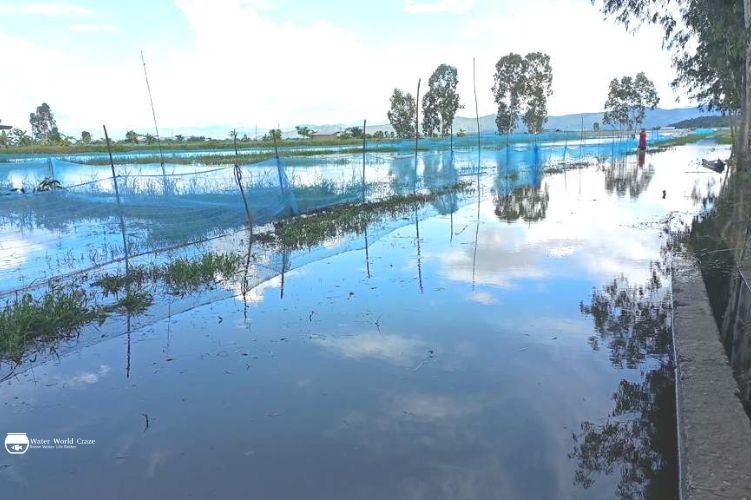As a aquaculture consultant with over 7 years of experience advising fish farm owners in India, I was distressed to hear the recent news of massive flooding at the fish farms in Kakching district. Read below about “Fish Farms Flooded- 200 Hectares Under Water in Kakching”.
Over 200 hectares of fish farms have been inundated after a nearby river overflowed due to heavy rains. This is a major setback for the local fish farmers who were looking forward to harvesting their stock in the coming months.
Table of Contents
Fish Farms Flooded- 200 Hectares Under Water in Kakching
Racing Against Time
I immediately contacted my client Mr. Verma, who owns a 60-acre fish farm in the affected region, to understand the on-ground situation. He informed me that the flood waters had risen up to 6 feet high and there was extensive damage to the fish enclosures. The low-lying topography of the farms and inadequate water drainage infrastructure aggravated the flooding.
As his farm expert, I told him to try to save the fish stock right away. The biggest problem was that the farms usually don’t have many boats or other ways to get around. Over the next two days, we worked nonstop to rent boats and make plans for getting feed bags, aerators, nets, and other tools to the underwater sites.
Our main goal was to save the 2 lakh Rohu and Catla fish that were going to be caught next month. Over the past year, we put a lot of money into growing this premium company. I called through my network of friends to quickly get more aerators, pumps, and generators. We knew we had to act quickly to save the fish until the floodwaters went down.
Catastrophic Losses
No matter how hard we tried, the damage was too wide to fix. In the three cages on Mr. Verma’s farm, we were only able to save 30% of the fish. Many other farms said they lost almost all of their fish because the water was too low on air.
I think that about 4 crore fish have died in the 200-hectare area that was flooded. With an average production rate of 3,000 to 5,000 kg of fish per hectare in the area, this means that the economy is losing crores of dollars. A lot of farmers took out loans and put their life savings into growing crops for this season.
It’s also very hard on the emotions to see months of hard work go away in just a few days. I want to help the farmers as they try to put things back together and start over. Also, the floods did a lot of damage to tools like aerators, pumps, and nets that need to be replaced.

Factors Exacerbating Flood Impact
My many years as an aquaculture specialist have taught me that fish farm owners need to plan for emergencies like floods. But the scale of devastation in Kakching exceeded all forecasts.
After analyzing the fallout, I have identified some key areas that aggravated the flood impact:
- Farms located in flood-prone low lying areas
- Deforestation resulting in rivers overflowing banks easily
- Lack of strong bunds/boundary walls around fish enclosures
- No warning or evacuation protocols for emergency events
- Insufficient boats & conveyance options for such a large flooded area
- Limited accessibility to fish farms due to broken rural roads
- Not enough backup equipment like aerators, generators, pumps etc
- Absence of community cool storage facilities for immediate fish evacuation
- Non-availability of excess fish handling capacity locally
- Lack of aquaculture disaster insurance to provide financial cushion
Roadmap for Future Preparedness
Going forward, I have suggested all my clients to revisit their farm infrastructure, operations and emergency plans. My recommendations include:
- Construct elevated bunds for fish enclosures based on highest flood level of the region
- Maintain adequate slope from bunds back into ponds for drainage
- Install more aerators, spread across grid for better oxygenation
- Place backup generators on elevated platforms secured with sandbags
- Lease boats and vehicles specially for emergency evacuation
- Have agreements with cold storages nearby for interim fish storage
- Arrange for extra labor and handling capacity during flood risk months
- Buy aquaculture insurance to cover farm infrastructure damage
- Increase farm accessibility by improving rural road network
- Set up community emergency warning system via phones & wireless
- Conduct mock drills for emergency fish evacuation periodically
Implementing these measures will help safeguard against future flood events. But this also requires collective action by all stakeholders including farmers, consultants like me, local administration and aquaculture technology providers. We need to work together to rebuild the affected region and fish farms for now.
Conclusion
The Kakching floods have left deep scars on the farmers as they struggle to recover from its devastating effects. As their advisor, I continue to explore financial, technical and labor assistance for them from government bodies and private companies. The journey to rebuild is long but we will support the farmers to eventually emerge stronger and more resilient. I hope you like reading “Fish Farms Flooded- 200 Hectares Under Water in Kakching”.

Marta, the driving force behind WaterWorldCraze.com, holds a Master’s degree in Marine Biology and has extensive experience in water sports and activities. With over 7+ years of hands-on experience in marine research and conservation, she has participated in numerous underwater expeditions and projects. Her passion for the aquatic world shines through in her expertly curated content. Join Marta as she explores the wonders of marine life and shares her adventures. Connect with her on Instagram @marinebiologymarta for more insights and updates.

